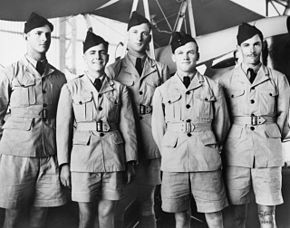No. 5 Elementary Flying Training School RAAF
| No. 5 Elementary Flying Training School RAAF | ||
|---|---|---|
Trainer Tiger Moth | | |
No. 5 Elementary Flying Training School (No. 5 EFTS) was a Royal Australian Air Force (RAAF) pilot training unit that operated during World War II. It was one of twelve elementary flying training schools employed by the RAAF to provide introductory flight instruction to new pilots as part of Australia's contribution to the Empire Air Training Scheme. No. 5 EFTS was established in June 1940 at Narromine, New South Wales, and primarily operated Tiger Moths. It ceased training in June 1944, after more than 3,700 students had passed through.
History

Flying instruction in the Royal Australian Air Force (RAAF) underwent major changes following the outbreak of World War II, in response to a vast increase in the number of aircrew volunteers and the commencement of Australia's participation in the Empire Air Training Scheme (EATS). The Air Force's pre-war pilot training facility, No. 1 Flying Training School at RAAF Station Point Cook, Victoria, was supplanted in 1940–41 by twelve elementary flying training schools (EFTS) and eight service flying training schools (SFTS).[1][2] The EFTS provided a twelve-week introductory flying course to personnel who had graduated from one of the RAAF's initial training schools. Flying training was undertaken in two stages: the first involved four weeks of instruction (including ten hours of flying) to determine trainees' suitability to become pilots. Those that passed this grading process then received a further eight weeks of training (including sixty-five hours of flying) at the EFTS. Pilots who successfully completed this course were posted to an SFTS in either Australia or Canada for the next stage of their instruction as military aviators.[1][3]
No. 5 Elementary Flying Training School (No. 5 EFTS) was formed at

As of 30 June 1940, only one of the No. 5 EFTS's four required hangars had been completed.
As of 30 September 1940, total strength was 467, including 114 trainees.[13] One student died and five others were injured off duty when the balcony of the Federal Hotel in Narromine collapsed on 11 November.[14] An instructor was killed and his pupil injured when their Tiger Moth stalled while attempting to avoid collision with another aircraft on 3 December.[6][15] Later that month, Squadron Leader Roy King, a fighter ace in the Australian Flying Corps during World War I, took over command of the school, serving until June 1941.[6][16] By that time, some 500 pupils had graduated from No. 5 EFTS; the wastage rate was just under twenty per cent.[17] Among the graduates was R.H. (Ron) Middleton, who subsequently flew with the Royal Air Force in Europe and was awarded a posthumous Victoria Cross for his actions piloting a Short Stirling bomber in November 1942.[18][19]
Night-flying training commenced at No. 5 EFTS in July 1941.
References
Notes
- ^ a b Stephens (2006), pp. 67–70
- ^ Gillison (1962), p. 111
- ^ Gillison (1962), pp. 106–109
- ^ a b Royal Australian Air Force (1939–45), p. 399
- ^ Ashworth (2000), p. 34
- ^ a b c d e f g h i RAAF Historical Section (1995), pp. 22–23
- ^ RAAF Historical Section (1995), p. 17
- ^ "Narromine". The Dubbo Liberal and Macquarie Advocate. Dubbo, New South Wales: National Library of Australia. 30 April 1940. p. 3. Retrieved 4 August 2014.
- ^ Royal Australian Air Force (1939–45), p. 400
- ^ Royal Australian Air Force (1939–45), pp. 399, 401
- ^ Royal Australian Air Force (1939–45), p. 416
- ^ Royal Australian Air Force (1939–45), p. 411
- ^ Royal Australian Air Force (1939–45), p. 419
- ^ Royal Australian Air Force (1939–45), pp. 444–445
- ^ "RAAF pilot killed". The Sydney Morning Herald. Sydney: National Library of Australia. 4 December 1940. p. 14. Retrieved 4 August 2014.
- ^ Garrisson, Australian Fighter Aces, p. 93
- ^ Royal Australian Air Force (1939–45), p. 505
- ^ Stephens (2006), pp. 104–106
- ^ Royal Australian Air Force (1939–45), p. 465
- ^ Royal Australian Air Force (1939–45), p. 525
- ^ Royal Australian Air Force (1939–45), pp. 577, 583
- ^ RAAF Historical Section (1995), pp. 17, 24
- ^ Royal Australian Air Force (1939–45), p. 646
- ^ Royal Australian Air Force (1939–45), pp. 667–668
- ^ Royal Australian Air Force (1939–45), pp. 681–684
Works consulted
- Ashworth, Norman (2000). How Not to Run an Air Force! The Higher Command of the Royal Australian Air Force During the Second World War: Volume 2. Canberra: Air Power Studies Centre. ISBN 0-642-26551-8.
- Garrisson, A.D. (1999). Australian Fighter Aces 1914–1953. Fairbairn, Australian Capital Territory: Air Power Studies Centre. ISBN 0-642-26540-2.
- Gillison, Douglas (1962). Australia in the War of 1939–1945: Series Three (Air) Volume I – Royal Australian Air Force 1939–1942. Canberra: Australian War Memorial. OCLC 2000369.
- RAAF Historical Section (1995). Units of the Royal Australian Air Force: A Concise History. Volume 8: Training Units. Canberra: ISBN 0-644-42800-7.
- Royal Australian Air Force (1939–45). Unit History Sheets: Nos. 1–7 Elementary Flying Training Schools. Canberra: National Archives of Australia.
- Stephens, Alan (2006) [2001]. The Royal Australian Air Force: A History. London: ISBN 0-19-555541-4.
